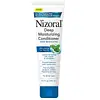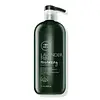What's inside
What's inside
 Key Ingredients
Key Ingredients

 Benefits
Benefits

 Concerns
Concerns

 Ingredients Side-by-side
Ingredients Side-by-side

Water
Skin ConditioningCetearyl Alcohol
EmollientBehentrimonium Chloride
PreservativeCeteareth-20
CleansingCetrimonium Chloride
AntimicrobialCaprylic/Capric Triglyceride
MaskingDimethicone
EmollientGlycerin
HumectantLinoleamidopropyl Pg-Dimonium Chloride Phosphate
Butyrospermum Parkii Butter
Skin ConditioningSimmondsia Chinensis Seed Oil
EmollientPanthenol
Skin ConditioningAllantoin
Skin ConditioningArginine
MaskingPolysorbate 80
EmulsifyingTocopherol
AntioxidantMentha Piperita Oil
MaskingMenthol
MaskingCamellia Sinensis Leaf Extract
AntimicrobialAscorbic Acid
AntioxidantMelaleuca Alternifolia Leaf Oil
AntioxidantXanthan Gum
EmulsifyingPhenoxyethanol
PreservativeDisodium EDTA
Potassium Sorbate
PreservativeCitric Acid
BufferingWater, Cetearyl Alcohol, Behentrimonium Chloride, Ceteareth-20, Cetrimonium Chloride, Caprylic/Capric Triglyceride, Dimethicone, Glycerin, Linoleamidopropyl Pg-Dimonium Chloride Phosphate, Butyrospermum Parkii Butter, Simmondsia Chinensis Seed Oil, Panthenol, Allantoin, Arginine, Polysorbate 80, Tocopherol, Mentha Piperita Oil, Menthol, Camellia Sinensis Leaf Extract, Ascorbic Acid, Melaleuca Alternifolia Leaf Oil, Xanthan Gum, Phenoxyethanol, Disodium EDTA, Potassium Sorbate, Citric Acid
Water
Skin ConditioningSodium Laureth Sulfate
CleansingAmmonium Lauryl Sulfate
CleansingCocamidopropyl Betaine
CleansingButylene Glycol
HumectantDecyl Glucoside
CleansingDimethicone
EmollientPCA Dimethicone
Skin ConditioningCocamide Mipa
EmulsifyingMelaleuca Alternifolia Leaf Oil
AntioxidantLavandula Angustifolia Extract
Skin ConditioningMentha Spicata Flower/Leaf/Stem Extract
MaskingGlycine
BufferingTyrosine
MaskingCysteine
AntioxidantLeucine
Skin ConditioningCetyl Alcohol
EmollientGlyceryl Distearate
EmollientIpdi/PEG-15 Soyamine Copolymer Dimer Dilinoleate
Skin ConditioningTrimethylolpropane Tricaprylate/Tricaprate
EmollientHydrogenated Polydecene
EmollientPEG-150 Distearate
EmulsifyingPolyquaternium-7
Cetyl Triethylmonium Dimethicone PEG-8 Succinate
Caprylyl Glycol
EmollientPhenoxyethanol
PreservativeHexylene Glycol
EmulsifyingSodium Coco Pg-Dimonium Chloride Phosphate
CleansingPanthenyl Ethyl Ether
Citric Acid
BufferingPolyquaternium-10
Histidine Hcl
Skin ConditioningDisodium EDTA
Methylchloroisothiazolinone
PreservativeMethylisothiazolinone
PreservativeMagnesium Chloride
Magnesium Nitrate
Glycerin
HumectantParfum
MaskingBenzyl Alcohol
PerfumingLimonene
PerfumingLinalool
PerfumingWater, Sodium Laureth Sulfate, Ammonium Lauryl Sulfate, Cocamidopropyl Betaine, Butylene Glycol, Decyl Glucoside, Dimethicone, PCA Dimethicone, Cocamide Mipa, Melaleuca Alternifolia Leaf Oil, Lavandula Angustifolia Extract, Mentha Spicata Flower/Leaf/Stem Extract, Glycine, Tyrosine, Cysteine, Leucine, Cetyl Alcohol, Glyceryl Distearate, Ipdi/PEG-15 Soyamine Copolymer Dimer Dilinoleate, Trimethylolpropane Tricaprylate/Tricaprate, Hydrogenated Polydecene, PEG-150 Distearate, Polyquaternium-7, Cetyl Triethylmonium Dimethicone PEG-8 Succinate, Caprylyl Glycol, Phenoxyethanol, Hexylene Glycol, Sodium Coco Pg-Dimonium Chloride Phosphate, Panthenyl Ethyl Ether, Citric Acid, Polyquaternium-10, Histidine Hcl, Disodium EDTA, Methylchloroisothiazolinone, Methylisothiazolinone, Magnesium Chloride, Magnesium Nitrate, Glycerin, Parfum, Benzyl Alcohol, Limonene, Linalool
Ingredients Explained
These ingredients are found in both products.
Ingredients higher up in an ingredient list are typically present in a larger amount.
Citric Acid is an alpha hydroxy acid (AHA) naturally found in citrus fruits like oranges, lemons, and limes.
Like other AHAs, citric acid can exfoliate skin by breaking down the bonds that hold dead skin cells together. This helps reveal smoother and brighter skin underneath.
However, this exfoliating effect only happens at high concentrations (20%) which can be hard to find in cosmetic products.
Due to this, citric acid is usually included in small amounts as a pH adjuster. This helps keep products slightly more acidic and compatible with skin's natural pH.
In skincare formulas, citric acid can:
While it can provide some skin benefits, research shows lactic acid and glycolic acid are generally more effective and less irritating exfoliants.
Most citric acid used in skincare today is made by fermenting sugars (usually from molasses). This synthetic version is identical to the natural citrus form but easier to stabilize and use in formulations.
Read more about some other popular AHA's here:
Learn more about Citric AcidDimethicone is a type of synthetic silicone created from natural materials such as quartz.
What it does:
Dimethicone comes in different viscosities:
Depending on the viscosity, dimethicone has different properties.
Ingredients lists don't always show which type is used, so we recommend reaching out to the brand if you have questions about the viscosity.
This ingredient is unlikely to cause irritation because it does not get absorbed into skin. However, people with silicone allergies should be careful about using this ingredient.
Note: Dimethicone may contribute to pilling. This is because it is not oil or water soluble, so pilling may occur when layered with products. When mixed with heavy oils in a formula, the outcome is also quite greasy.
Learn more about DimethiconeDisodium EDTA plays a role in making products more stable by aiding other preservatives.
It is a chelating agent, meaning it neutralizes metal ions that may be found in a product.
Disodium EDTA is a salt of edetic acid and is found to be safe in cosmetic ingredients.
Learn more about Disodium EDTAGlycerin is already naturally found in your skin. It helps moisturize and protect your skin.
A study from 2016 found glycerin to be more effective as a humectant than AHAs and hyaluronic acid.
As a humectant, it helps the skin stay hydrated by pulling moisture to your skin. The low molecular weight of glycerin allows it to pull moisture into the deeper layers of your skin.
Hydrated skin improves your skin barrier; Your skin barrier helps protect against irritants and bacteria.
Glycerin has also been found to have antimicrobial and antiviral properties. Due to these properties, glycerin is often used in wound and burn treatments.
In cosmetics, glycerin is usually derived from plants such as soybean or palm. However, it can also be sourced from animals, such as tallow or animal fat.
This ingredient is organic, colorless, odorless, and non-toxic.
Glycerin is the name for this ingredient in American English. British English uses Glycerol/Glycerine.
Learn more about GlycerinThis tea tree oil comes from the leaves of the Tea Tree plant. Tea tree oil has antioxidant, anti-inflammatory, and antimicrobial properties.
According to the book Journal of Profiles of Drug Substances, tea tree helps in reducing acne-causing bacteria such as Propionibacterium acnes. This is due to the Terpinen components of tea tree oil.
Tea tree may cause sensitivity and irritation for some people. This oil naturally contains fragrance such as linalool and limonene.
However, research shows irritation usually occurs when using pure tea tree oil and not in cosmetic products.
Tea tree oil was found to help relieve the symptoms of psoriasis in one study.
Tea tree oil is toxic when ingested. Another study showed it to caused damage to the nervous system of dogs and cats when applied to their skin or given orally.
Learn more about Melaleuca Alternifolia Leaf OilPhenoxyethanol is a preservative that has germicide, antimicrobial, and aromatic properties. Studies show that phenoxyethanol can prevent microbial growth. By itself, it has a scent that is similar to that of a rose.
It's often used in formulations along with Caprylyl Glycol to preserve the shelf life of products.
Water. It's the most common cosmetic ingredient of all. You'll usually see it at the top of ingredient lists, meaning that it makes up the largest part of the product.
So why is it so popular? Water most often acts as a solvent - this means that it helps dissolve other ingredients into the formulation.
You'll also recognize water as that liquid we all need to stay alive. If you see this, drink a glass of water. Stay hydrated!
Learn more about Water